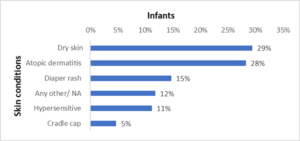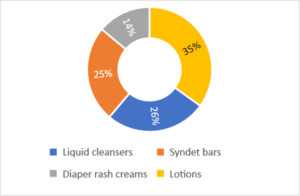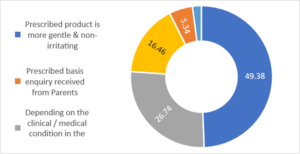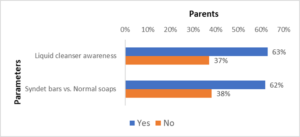Sourabh Duwarah1, Ashim Ghosh2, Dyotona Sen3, Sanjay Choudhary4*
1Pediatrician, UHS Vista Superspeciality Clinic and Diagnostic Centre, Assam, India
2Pediatrician, Apcar garden, Asansol, West Bengal, India
3Head Medical Affairs – India and South Asia, Galderma, Mumbai, Maharashtra, India
4Manager, Medical Affairs-India and South Asia, Galderma, Mumbai, Maharashtra, India
*Correspondence author: Sanjay Choudhary, Manager, Medical Affairs-India and South Asia, Galderma, Mumbai, Maharashtra, India;
Email: [email protected]
Published Date: 19-09-2024
Copyright© 2024 by Duwarah S, et al. All rights reserved. This is an open access article distributed under the terms of the Creative Commons Attribution License, which permits unrestricted use, distribution, and reproduction in any medium, provided the original author and source are credited.
Abstract
Objective: Newborn skin is incredibly delicate and vulnerable to issues like dermatitis and infections, which are prevalent in infants in India. To ensure optimal care and results, parents and caregivers must know about infant skincare products and implement a targeted and comprehensive skincare routine. This study aimed to gain insight into the best baby skincare practices as per dermatologists, pediatricians and cosmetologists (Healthcare Professionals [HCPs]), on product prescribing patterns in India and parent’s awareness of the neonatal skincare armamentarium.
Methods: An online survey was conducted to assess the best baby skincare practices as per HCPs on product prescribing patterns in India and parent’s awareness of the neonatal skincare armamentarium. Here, a total of 59 HCPs participated in this survey on Cetaphil baby products range (Galderma) conducted to find out the prescribing pattern for baby skincare products and to record parents’ awareness of the available products.
Results: The survey showed that dry skin (29%), atopic dermatitis (28%) and diaper rash (15%) were the most encountered skincare problems by HCPs in newborns. The HCPs reported that liquid cleansers (26%) and syndet bars (25%) are some of the most prescribed products and were deemed fit for the majority of the newborns (49%), owing to their gentle and non-irritating properties. A complete skincare regime (cleanser, lotion, diaper cream) was also prescribed to most infants (69%). Moreover, most parents were aware of liquid cleansers for newborns (63%) and the majority of them (62%) knew the difference between syndet bars and normal soaps.
Conclusion: Proper product prescription and utilization by HCPs and parents is key to ensuring healthy skin development in newborns. Following an extensive skincare regime inclusive of gentle cleansers, moisturizing lotions and barrier creams from an early stage is essential to protect newborn skin and achieve the desired results.
Keywords: Newborn Skincare; Dermatitis; Infection; Cetaphil Baby Products
Introduction
As newborns transition from the wet uterine environment to the extrauterine world, the structure and function of their skin continue to advance. Newborn infant skin is distinctly different compared to juveniles and adults, making it susceptible to thermal instability, damage and infection. Clinico-etiological studies reveal that transient physiological disorders, atopic dermatitis, diaper dermatitis and infectious disorders are some of the most prevalent skin conditions in neonates and infants in India [1-3].
Introduction
As newborns transition from the wet uterine environment to the extrauterine world, the structure and function of their skin continue to advance. Newborn infant skin is distinctly different compared to juveniles and adults, making it susceptible to thermal instability, damage and infection. Clinico-etiological studies reveal that transient physiological disorders, atopic dermatitis, diaper dermatitis and infectious disorders are some of the most prevalent skin conditions in neonates and infants in India [1-3].
A targeted newborn skincare regimen is required to nurture their skin, safeguard it from irritation and inflammation, ensure development and produce an overall sense of well-being [1-3]. The wide range of baby care products in the market and skincare recommendations by professionals, consumer magazines and information on the internet often leave parents and care providers confused and unsure of which products would be best suitable for their infants [1]. Cleansers, soaps, baby powders, oils, shampoos, diaper rash creams and wipes are some of the routinely used skincare products for newborns in India [7]. Standard recommendations for skincare for newborns and infants state that ideal skincare for newborns should aim to gently cleanse, protect barrier function and prevent skin dryness and trauma, which could be achieved through a comprehensive routine involving the use of appropriate cleansers, lotions, diaper rash creams and fragrance-free wipes [8].
Guidelines suggest that syndet bars are optimal cleansers and should be preferred to soaps, as they do not damage the epidermal barrier. Liquid cleansers with a proper blend of surfactants and acidic or neutral pH are also recommended, as they maintain the acidic mantle of the skin and its barrier function [8]. Selection of appropriate preservative and perfume-free emollients is advised for babies at a higher risk of developing dry skin and associated conditions like atopic dermatitis, to rebuild barrier integrity and prevent further damage to the skin [8]. Diaper rash is another common condition of concern for physicians and parents. The application of creams to the diaper area, along with good cleaning practices and repeated diaper changes are effective rash prevention strategies that could promote reparation of the skin [9].
Parents of infants with skin disorders tend to seek information from multiple sources to provide the best possible care to manage the condition in newborns, which increases the chances of misinformation on the disease and treatment and may lead to inadequate outcomes [10]. Thus, in today’s age of online search engines, parental awareness of products to be used for various skin conditions, steering clear of harmful ingredients and including mild, non-irritating products in the daily regimen for healthy skin is pivotal for favorable results.
The present study aimed to understand the dermatologists’, pediatricians’ and cosmetologists’ (Healthcare Professionals [HCPs]) perspective on managing skin conditions in newborns and newborn skincare prescribing patterns and to assess parents’ or caregivers’ awareness about the available baby skincare products.
Methods
Study Design
This study was conducted as part of a survey series on multiple dermatology products across India, from June-December (2022). More than 1000 HCPs were registered pan India for the survey series. Every month, a product-specific survey link was released for these registered HCPs and each HCP could take up to 10 surveys for a maximum of 2 products. A total of 59 HCPs participated in this survey on ‘Cetaphil baby products range’ (Galderma) conducted to find out the prescribing pattern for baby skincare products and to record parents’ awareness of the available products.
Data Collection and Analysis
Data was collected using a structured questionnaire having 11 questions. The survey link was rolled out in 2 phases: July and October 2022. The survey responses were analyzed using Microsoft Excel spreadsheet version 2021 and the descriptive statistics were calculated using predefined Excel formulas.
Results
Infant Demographics and Skin Conditions
Data on a total of 254 infants were collected through the survey. With an almost equal proportion of boys (52%) and girls (48%), most of the infants (82%) included in the survey were older than 2 months and had medical skin conditions (74%). Dry skin was the most commonly reported skin condition in these infants (29%), closely followed by atopic dermatitis (28%) and diaper rash (15%) (Fig. 1).
Skincare Products Prescribing Pattern
The survey analysis indicates that the following products were prescribed to most infants: Lotions (35%), liquid cleansers (26%) and syndet bars (25%) (Fig. 2). When asked about the reason for prescribing liquid cleansers/syndet bars, the HCPs revealed that they were prescribed to most of the patients (49.38%), owing to their gentle and non-irritating properties. Cleansers were also prescribed to some patients (26.74%) depending on their clinical condition and to a few patients (16.46%) based on the HCPs’ expertise and preference (Fig. 3). The duration of the prescription of liquid cleansers for most of the patients (30%) was 2-3 months. Additionally, most of the patients (69%) were prescribed a complete regimen comprising cleanser, lotion and diaper cream.
Parents’ or Guardians’ Awareness of Baby Skincare Products
Parental/guardians’ awareness of baby skincare products was also assessed through the survey and the analysis revealed that parents of most of the infants (63%) were aware of the baby skincare liquid cleansers and an equal proportion (62%) was also aware of the differences between baby syndet bars and normal soaps (Fig. 4). Moreover, parents of most infants (57%) enquired regarding the usage of baby wipes for newborns.

Figure 1: Common skin conditions in infants.

Figure 2: Commonly prescribed skincare products.

Figure 3: Reasons for prescribing liquid cleansers or syndet bars.

Figure 4: Parental/guardian awareness of baby skincare products.
Discussion
Newborns and infants have physiologically fragile skin, with reduced resistance to trauma and environmental aggression. A growing body of evidence shows that although their skin appears to be normal superficially, it is constantly undergoing internal transitions to adapt to the outside world. The anatomical and functional differences in infant skin include compromised water handling properties, higher skin pH and drier skin. Thus, skincare practices for newborns and infants should support skin barrier adaptation and address trauma sensitivity and related concerns [11].
Constant exposure to trauma coupled with the delicate nature of their skin makes them prone to skin conditions and infections. A study of skin disorders in the pediatric population in a tertiary healthcare center in western India reported dermatitis to constitute most of the skin conditions (20.61%) in neonates. Seborrheic dermatitis and diaper dermatitis were the most common dermatitis disorders in that age group [3]. This is somewhat in line with the current study, in which dry skin, atopic dermatitis and diaper rash were the most prevalent conditions in newborns.
Focusing on comprehensive skincare regimens that reinforce skin barrier development in newborns could help reduce the potential for skin issues. A randomized pilot study conducted to compare the effects of near-daily wash with a mild liquid cleanser followed by lotion application (Group A), just water wash followed by baby lotion application (Group B) and water alone (Group C) in babies with mildly deteriorated skin reported that bathing infants with a mild liquid cleanser followed by moisturizer specifically developed for baby skin was gentler on the skin, compared to the other regimens. This regimen was also effective in retaining skin moisture, enhancing skin barrier function and balancing skin pH [12]. In the current study, lotions and liquid cleansers were the most prescribed products and liquid cleansers were mostly prescribed because they are gentle and non-irritating.
Proper cleansing is critical to promote the development of a healthy epidermis in newborns. Parents and caregivers should be familiar with the primary differences between traditional soaps and cleansers with synthetic detergents (syndets) to provide optimal care. Soaps are fatty acid salts and are basic in nature, which could deprive the skin of natural moisturizing factors and give rise to skin problems. Syndet bars conversely are milder and have lesser potential to irritate the skin. Liquid cleansers efficiently deliver emollients and occlusives to deeper layers of the skin and have been largely gaining visibility in recent research [13]. The current study revealed that most of the parents were aware of the differences between normal soaps, syndet bars and liquid cleansers.
Further, due to continuous exposure to urine, feces and overhydration, the diaper area is more prone to skin irritation which causes pain and discomfort in infants. Hence, in addition to gentle cleansing, experts recommend the inclusion of barrier preparations to keep infant skin in sensitive areas healthy and prevent conditions like diaper dermatitis. In tandem with this recommendation, a complete regimen comprising cleanser, lotion and diaper rash cream was prescribed to most of the patients in the current study. Moreover, caretaker behaviour and certain product ingredients can play a role in diaper dermatitis progression. In recent years, studies have demonstrated that products such as baby wipes are effective and superior to cloth and water to keep the diaper area clean [14,15]. In the present study, most of the parents enquired about the use of baby wipes for newborns.
Conclusion
Given the vulnerability of newborn skin, appropriate product prescription and utilization practices by HCPs and parents are central to avoiding skin damage and preserving and maintaining the skin barrier function and integrity. However, information overload with the community and culture-driven skincare practices is common in settings like India. The HCPs should identify the risk of developing skin conditions in neonates and devise suitable strategies for skincare with safe and non-irritating products. Being primary caregivers, parents should be cognizant of ideal products to be used for babies to achieve favourable outcomes. Through this survey-based study, it was observed that following an extensive newborn skincare regime inclusive of gentle cleansers, moisturizing lotions and barrier creams from an early stage can go a long way in maintaining healthy skin in neonates and infants.
Conflict of Interests
The authors declare that there is no conflict of interest for this paper.
Acknowledgment
We acknowledge the medical writing support provided by Medicca Press Ltd.
Acknowledgment
We acknowledge the medical writing support provided by Medicca Press Ltd.
References
- Blume-Peytavi U, Hauser M, Stamatas GN, Pathirana D, Garcia Bartels N. Skin care practices for newborns and infants: review of the clinical evidence for best practices. Pediatric Dermatology. 2012;29(1):1-4.
- Afsar FS. Physiological skin conditions of preterm and term neonates. Clin Exp Dermatol. 2010;35(4):346-50.
- Jawade SA, Chugh VS, Gohil SK, Mistry AS, Umrigar DD. A clinico-etiological study of dermatoses in pediatric age group in tertiary health care center in South Gujarat region. Indian J Dermatol. 2015;60(6):635.
- Oranges T, Dini V, Romanelli M. Skin physiology of the neonate and infant: clinical implications. Adv Wound Care (New Rochelle). 2015;4(10):587-95.
- Yonezawa K, Haruna M. Short-term skin problems in infants aged 0-3 months affect food allergies or atopic dermatitis until 2 years of age, among infants of the general population. Allergy, Asthma Clin Immunol. 2019;15(1):74.
- Misery L, Taieb C, Brenaut E, Huet F, Abasq-Thomas C, Sayag M, et al. Sensitive Skin in Children. Acta Derm Venereol. 2020;100(1):5640.
- Sarkar R, Basu S, Agrawal RK. Skin care for the newborn. Indian Pediatr. 2010;47:593-98.
- Madhu R, Chandran V, Anandan V, Nedunchelian K, Thangavelu S, Soans ST, et al. Indian academy of pediatrics guidelines for pediatric skin care. Indian Pediatr. 2021;58:153-61.
- Šikić Pogačar M, Maver U, Marčun Varda N, Mičetić‐Turk D. Diagnosis and management of diaper dermatitis in infants with emphasis on skin microbiota in the diaper area. Int J Dermatol. 2018;57(3):265-75.
- Reljić V, Gazibara T, Nikolić M, Zarić M, Maksimović N. Parental knowledge, attitude and behavior toward children with atopic dermatitis. Int J Dermatol. 2017;56(3):314-23.
- Blume‐Peytavi U, Tan J, Tennstedt D, Boralevi F, Fabbrocini G, Torrelo A, et al. Fragility of epidermis in newborns, children and adolescents. J Eur Acad Dermatol Venereol. 2016;30:3-56.
- Duan Y, Ma L, Galzote C, Kong FQ, Shen CP. A randomized pilot clinical assessment of three skincare regimens on skin conditions in infants. Clin Cosmet Investig Dermatol. 2019;12:895-909.
- Blume‐Peytavi U, Lavender T, Jenerowicz D, Ryumina I, Stalder JF, Torrelo A, et. al. Recommendations from a European Roundtable Meeting on Best Practice Healthy Infant Skin Care. Pediatr Dermatol. 2016;33(3):311-21
- Blume‐Peytavi U, Hauser M, Lünnemann L, Stamatas GN, Kottner J, Garcia Bartels N. Prevention of diaper dermatitis in infants-a literature review. Pediatr Dermatol. 2014;31(4):413-29.
- Rodriguez KJ, Cunningham C, Foxenberg R, Hoffman D, Vongsa R. The science behind wet wipes for infant skin: Ingredient review, safety and efficacy. Pediatr Dermatol. 2020;37(3):447-54.
Article Type
Review Article
Publication History
Received Date: 20-08-2024
Accepted Date: 11-09-2024
Published Date: 19-09-2024
Copyright© 2024 by Duwarah S, et al. All rights reserved. This is an open access article distributed under the terms of the Creative Commons Attribution License, which permits unrestricted use, distribution, and reproduction in any medium, provided the original author and source are credited.
Citation: Duwarah S, et al. A Survey on Neonatal and Infant Skincare: Indian Dermatologists, Pediatricians and Cosmetologists’ Perspective on Product Prescription Pattern and Parents’ Awareness. J Dermatol Res. 2024;5(3):1-6.

Figure 1: Common skin conditions in infants.

Figure 2: Commonly prescribed skincare products.

Figure 3: Reasons for prescribing liquid cleansers or syndet bars.

Figure 4: Parental/guardian awareness of baby skincare products.


